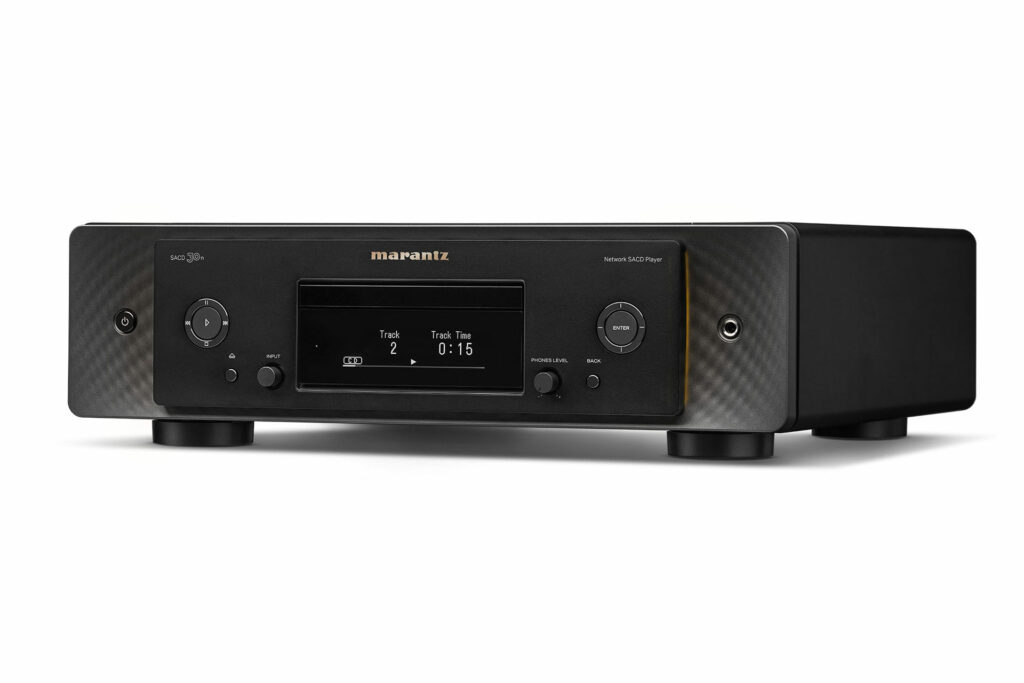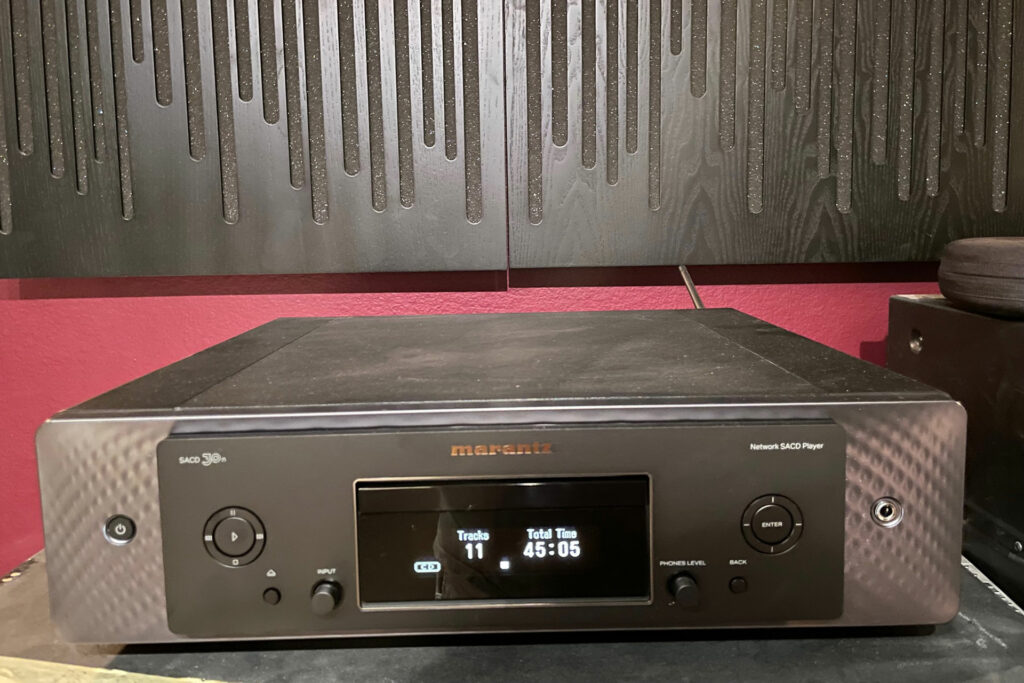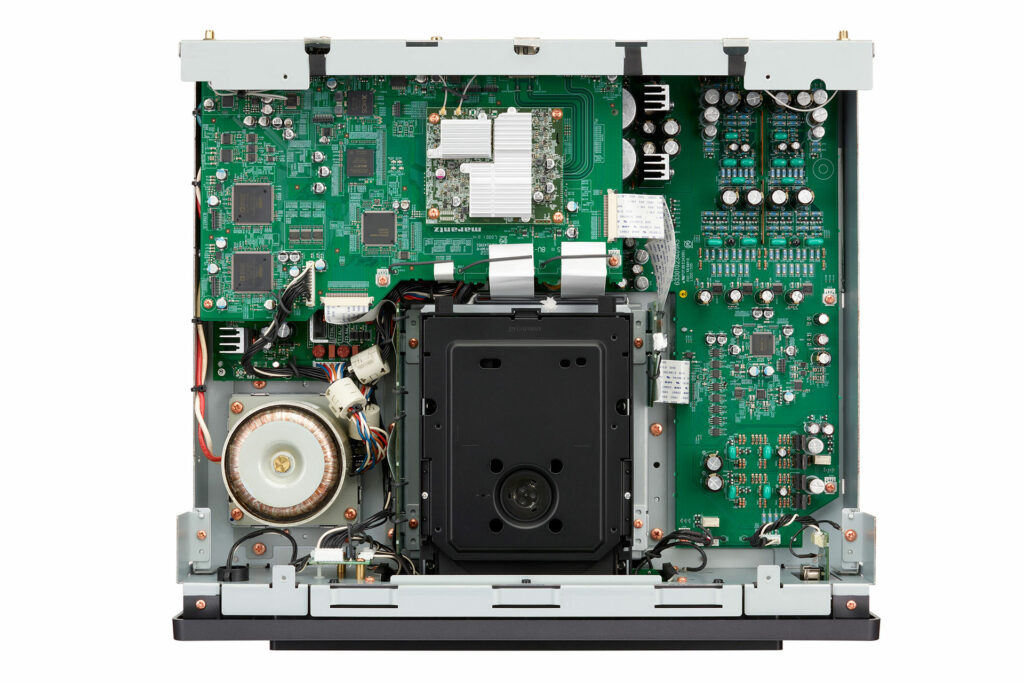The Marantz SACD 30n SACD player (buy at Crutchfield), like the recently reviewed Model 30 integrated amplifier, has a blend of old-school features and design with modern technology. Marantz calls the SACD 30n a complete digital source player, and while it does not handle every known digital format (DVD-Audio, for example), this player can decode and deliver the vast majority and certainly the most of the popular ones. At $2,999, it’s priced above mass-market disc spinners and streamers, but significantly less than many audiophile digital sources.

What Makes the Marantz SACD 30n Audiophile Disc Player Special?
- The SACD 30n is carefully built in Marantz’s Shirakawa Audio Works facility in Japan in an era where many products like this are made in China or Vietnam. This facility houses a powerful group of audiophile engineers as well as dozens of skilled audio craftspeople, many with close to 40 years of experience.
- The SACD 30n sports the same striking industrial design found on the Model 30 integrated amplifier. Both are available in either Silver Gold or Black finish. While black is likely to outsell silver based upon versatility, the Silver/Gold is a warm metallic tone that provides a gorgeous, clean, classic look, especially with both components stacked.
- As with Marantz’s integrated amplifier, there is a floating aluminum panel flanked by gently curved side panels that have elongated dimples reminiscent of those on a golf ball or a tufted fabric. Unlike the integrated amplifier, there is no porthole display. Rather, there is a slim disc drawer over a large OLED display.
- The side panels feature a discreet power button on the left side; visual balance is provided by the quarter-inch headphone jack on the right-side panel. Adjustable lighting behind the floating panel that illuminates the side panels makes for a classy presentation in a darkened room. For those of you who do not like it, the lighting is defeatable. If you connect the Marantz SACD 30n to the Model 30 integrated, you can synchronize the lighting and other controls.
- A back panel full of connections hints at the versatility of the SACD 30n. Marantz has loaded up the player with Ethernet connectivity, dual antennas for Wi-Fi and Bluetooth, as well as USB A & B, coaxial digital, and a pair of optical inputs. There are two sets of single-ended analog outputs, fixed and variable, as well as one each coaxial and optical outputs. In addition to the audio connectivity, there are remote control in/out, IR flasher in/out, and RS-232 connections to keep the custom installers happy. Notably missing are balanced analog outputs. Some may lament the lack of AES or I2S digital connections, but I suspect they a very few in number.
- The multitude of physical inputs coupled with Marantz parent company Masimo’s HEOS multiroom wireless distributed music system, allows the SACD 30n to accept digital signals in a wide variety of formats up to 384 kHz/32-bit for PCM and 11.2 MHz for DSD. Of course, you can also play your CDs and SACDs as well as their re-writeable variants.
- The HEOS integration, in addition to providing audio streaming through a multitude of sources, also provides control via numerous interfaces, including voice control through Alexa, Google, and Siri. The HEOS ecosystem is not perfect, but it’s quite good and makes for easy integration with a large variety of components.
- The Marantz SACD 30n uses a custom Marantz Musical Mastering system in place of an off-the-shelf DAC chipset. The Marantz system takes incoming PCM signals and converts them to DSD for processing. The processing includes the implementation of selectable filters. The default is Filter 1, which I found a bit rolled off for my tastes; Filter 2 was my preferred option. It was nice to have the option to accommodate different systems.
- The SACD 30n was tuned by the Marantz Sound Master (their term, not mine) to achieve the desired voicing. Not surprisingly, the SACD 30n uses HDAM-SA3 circuitry. However, I was surprised to see that the headphone amplifier gets its own HDAM-SA2 circuit with independent gain setting. You may have noted the two sets of analog outputs noted above: fixed and variable. Why not just have variable outputs? When using the fixed outputs, the preamplifier is out of the signal path, providing for a cleaner signal. This is a nice touch and hints at the decisions made throughout the design process to maximize sound quality.

Why Should You Care About the Marantz SACD 30n SACD Player?
My friends have been telling me for years about how they do not own physical media anymore and they can stream whatever they want at any time. They have a point; streaming is a great way to explore new music and have access to nearly anything at any time. That said, for music I really enjoy, I want to have a physical copy. This means when that artist no longer has an agreement with the streaming platforms I use, I can still listen to my music. When my internet is down because Spectrum is doing maintenance and I cannot work, at least I can still listen to my physical media. Lastly, I enjoy going to music stores and searching for music. Thankfully, the Marantz SACD 30n allows me to either stream or play physical media without sacrificing quality.

Some Things You Might Not Like About the Marantz SACD 30n SACD Player
- There is no multi-channel decoding or output. One of SACD’s selling points is its ability to provide multi-channel audio. If you peruse audiophile forums, you will no doubt come across many threads discussing the pros and cons of various multichannel SACD remixes. The Marantz SACD 30n only plays the stereo layer of the SACD, though.
- There are no MQA capabilities and Roon compatibility is limited. Master Quality Authenticated is a lossy codec that is designed to provide audiophile quality sound in a smaller package, making it easier to stream. Audio enthusiasts find MQA polarizing, in that some love it and others hate it. Those who are fans may lament the lack of MQA.
- The Marantz SACD 30n is Roon Tested, which means Roon users can play to the SACD 30n, but only through AirPlay, which may has resolution limits lower than some of the high-resolution streaming services are capable of. That said, there is a new Roon extension called RHEOS that I am playing with now that looks like a promising fix to this.
- There are no balanced outputs. While I understand why Marantz did not include balanced outputs, it would have made the SACD 30n a more attractive option for those looking for a digital source for their balanced systems.
Listening to the Marantz SACD 30n SACD Player…
I used the SACD 30n mostly with the recently reviewed Marantz Model 30 integrated amplifier, but also with my reference stereo system with a McIntosh C-500 preamplifier driving the amplifier section of a Krell F.B.I.
The same remote can control both the Marantz SACD 30n and Model 30 integrated amplifier, reducing coffee table clutter and making it easy to control music playback and volume at the same time. The new Marantz remotes are slimmer, more solid, and feel nicer than prior iterations.
I will start with a track from my recent review of the Model 30 integrated amplifier that does good job capturing the essence of what I heard during my many listening sessions.
Eric Clapton’s “Layla” from The Lady in the Balcony (Qobuz, 96 kHz) did a great job in capturing the detail in Clapton’s voice and guitar playing. As a good music playback system should, the Marantz system provides an emotionally moving performance. The acoustic guitar notes were natural and detailed, making it easy to hear Clapton’s manipulations of the strings and percussion on the body of the guitar. Of course, Clapton’s distinctive voice was immediately identifiable, as were the slight changes that come with age, making it easy to discern that this was mature Clapton, not youthful Clapton. Clapton was solidly positioned in between and slightly behind the speakers, with an overall soundstage that extended horizontally slightly beyond the speakers. As I noted in my review of the Model 30 integrated amplifier, there was a slight warmth in the midbass that added a bit of weight or fullness, but without any apparent obscuring of detail.
I have Dire Straits’ seminal album Brothers in Arms on both CD and SACD and went straight to the opening minute or so of the title track “Brothers in Arms” to check out the SACD 30n’s disc spinning abilities. The CD version sounded quite good, but I found the stereo layer of the SACD to provide a bit more detail, adding some grit to the opening electric guitar riff. The drums on the CD version may have had a touch more weight, but the SACD was tighter and punchier. I listen to a lot of live music as my son plays low brass in his school band, so I also listened to the track “Your Latest Trick,” which features trumpet and saxophone parts, that, while on the mellow side, are reproduced with the appropriate dynamics and tonality. There was a touch more detail in the SACD version that made it sound more believable. There are a bunch of versions of this album, and with all of the remastering I cannot conclusively say the differences between the CD and SACD are due to format and not mastering, but I heard similar differences in a couple other CD to SACD comparisons as well, so I am going with the format as being the major difference between the two.
In addition to having the SACD 30n’s fixed output connected to the CD input of the Marantz Model 30 (buy at Crutchfield), I also tried using the variable output connected to the amplifier input. This bypasses the Model 30’s preamplifier section and uses the variable output of the SACD 30n to act as the volume control. I preferred the fixed output of the SACD 30n and using the Model 30’s audiophile preamplifier section as it had less noise and better dynamics. I did some listening through the headphone output with my Cleer Audio Next headphones (read the review) with the headphone amplifier set to its mid gain level and a few different in-ear monitors, including the Shure SE846 and Ultimate Ears Reference Remastered (read the review). The headphone amplifier was dynamic and clean, with quiet backgrounds and without any noticeable distortion. Using the high output setting with Cleer Audio Next’s there was a hint of noise, so I switched back to the mid-level setting, which provided plenty of power and less noise.
Does the Marantz SACD 30n SACD Player Have Any Resale Value?
Digital source devices will never retain value as well as other component types such as amplifiers or floorstanding speakers. That said, the Marantz SACD 30n’s versatility will also provide it with longevity for nearly ever audiophile. The ability to act as a DAC with other digital source components means you can still use the SACD 30n’s DAC when you have a new source. On the flip side, if there is a new DAC that you absolutely fall in love with, you can still use the disc transport and streaming of the SACD 30n to output a digital signal to your new favorite DAC. Further, the Marantz 30n’s firmware can be upgraded to accommodate new streaming services.

Who Is the Competition For the Marantz SACD 30n SACD Player?
Close in price and features is the Technics SL-G700M2, which is $500 more at $3,499 and offers a very similar feature set, with SACD playback, headphone output, and a full array of network streaming options. There is no HEOS system, as HEOS is found only on Masimo Consumer products, but it does have Chromecast and if you want balanced analog outputs, you are in luck.
The nearly twice-as-expensive Mark Levinson No. 5101 ($6,700) also has balanced outputs but no headphone output. I have not had the chance to spend any time with this player, but I have seen this series at trade shows and their build quality is extremely nice. As for sound quality, I found Mark Levinson to be quite capable with their DACs when listening to some of their slightly older products, which leads me to believe the No. 5101 will be no slouch.
Last, but not least is Oppo’s spiritual successor, Reavon. Reavon has three models: the UBR-X100, 110, and 200. The 100 and 110 are digital only, so I am skipping them for this comparison. The UBR-X200 at €1,799 ($1,980 U.S. Dollars) is truly a universal disc player with audio and video capabilities. The UBR-X200 also has eight channels of DACs, an HDMI audio only output, as well as balanced stereo outputs. I do not know anyone who has one so I am curious about how it will actually perform. The Reavons do not have headphone outputs but the feature that most will miss is streaming, since it does not appear from reviewing the Reavon website that there is a way to stream nor is there a digital input to connect a streamer to.
Final Thoughts on the Marantz SACD 30n SACD Player
I think of the SACD 30n as a high-performance, digital audio version of a Swiss Army knife. Unlike most Swiss Army knives that I’ve owned, which do few tasks particularly well, the Marantz does many tasks extremely well. It is full of functionality and with the few caveats noted above, it provides this functionality and performance in an easy-to-use package. I enjoyed being able to access all of my stereo digital music through one source rather than having to switch between devices to listen to streaming or physical media. Of course, this convenience would not be worth much if the quality was not both high and consistent. The Marantz SACD 30n not only makes all of your two-channel tunes readily available, but performs extremely well when playing it back, making it very easy to spend hours listening to your favorite music.
Marantz SACD 30N FAQ
Does the Marantz SACD 30N play DVD-Audio discs?
No.
But other more “universal” SACD players do such as the legendary but long-ago out of business Oppo Digital BDP-205 and BDP-203
Is SACD a dead audiophile format?
Yes.
Most music is made in PCM not native DSD which is the main audio advantage of SACD.
SACD didn’t support video which was fatal to its hope of being the “next Compact Disc”
With the exception of Dark Side of the Moon from Pink Floyd, most SACDs sold very poorly. DVD-Audio discs sold even fewer copies.
Are SACD discs still made today?
Yes.
But they are very rare.
Silver discs are rare as of 2025.
Will the Marantz SACD 30N play a DVD-Video Disc?
No.
Will a Marantz SACD 30N play a Blu-Ray Disc/movie?
No.
Is the Marantz SACD 30N a good Compact Disc player?
Audiophiles tend to agree that the Marantz SACD 30N is an excellent CD player for playing legacy Compact Discs as well as legacy SACDs thus its appeal.
Is the Marantz SACD 30N well-made?
Yes sir.
The Marantz SACD 30N is built like a tank and should last at least a decade (if not longer) playing your last silver discs.
Is the Marantz SACD 30N made in the United States?
No.
Who owns Marantz these days?
Marantz was just sold from medical services company, Masimo to the Samsung-owned Harman based in Los Angeles.




I’d like to win this!!
Who wouldn’t.
We are giving away a pair of MartinLogan speakers ENDING TODAY.
We’ve got Kanto powered speakers sweeps starting tomorrow. Be sure to get in on both. No cost but No Marantz – you are going to need to buy yours.
I am going to pick up the review sample in Malibu from Brian Kahn tomorrow and trade him my Pass Labs XP-22 preamp for he and Greg Handy to listen too.
Jealous?
I am doing a Jay’s Audio CD player review (on its way to me) and I want to compare the two silver disc players.
I don’t do much for silver disc players for my listening as streaming is both better and easier BUT I know a bunch of audio guys who still ONLY listen to CDs so we will cover that angle for them too! 🙂
I just borrowed this unit from Brian to hear in my system.
One small detail is that it is EVER TO WIDE to fit in a standard equipment rack. Arg… I have a solution that will work however 🙂
A good friend recently bought a Marantz 30n SACD player. It is an impressive looking piece of equipment. He previously had a Yamaha player but wanted the additional streaming features and upgraded DAC. Its ability to integrate multiple sources and platforms is exactly what he was looking for. The remote is solid feeling with a good weight to it. However, it’s a bit hard for “older eyes” to read in low light. Perhaps if the backlight was a touch brighter. Maybe it’s time for an updated prescription for my reading glasses. If I was a streamer, I’d look into one for my system.